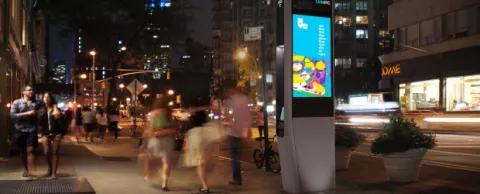
New York City’s pay phones are beginning to disappear, but chances are nobody will miss them. They’re being replaced with new kiosks that offer everything except a private, enclosed space.
The new kiosks, called LinkNYC, will not only make phone calls, but they will make free calls to anywhere in the United States. They will also recharge mobile phones. And they’ll offer blazing fast Internet, capable of letting people download HD movies in seconds.
There will also be more of them. The network could grow to 10,000 kiosks; there are only about 8,400 pay phones now.
Council Lead Partner Qualcomm is part of CityBridge, a group of six companies building the new network of kiosks. Perhaps the best part is that it doesn’t cost the city anything. In fact, it’s expected to deliver hundreds of millions in revenues over the next decade.
They’re phones, just not ‘pay’ phones
New York is only really losing the ‘pay’ part of pay phones. The new kiosks not only make free calls, they also provide rapid access to 911 emergency help and government information and non-emergency services.
Given that there’s no enclosed space, or even a handset, phone calls are made over a speaker phone. Since many of the city’s pay phone booths are rarely used, the lack of privacy with the new kiosks may not be an issue.
Gigabit Internet for everyoneThe big advance for New York is that LinkNYC provides something that most residents need: gigabit Internet. Each kiosk serves as a wireless hotspot. It’s one of the first free, secure WiFi hotspot networks in the country, and one of the fastest in the world.
While the speeds will vary somewhat depending on the availability of fiber in a particular neighborhood, LinkNYC boasts that it will be about 100 times faster than the average municipal WiFi system, and 20 times faster than the average in-home Internet service currently in the city.
Closing the digital divide has been one of the key areas of focus for the city. New York’s low-income residents often have cell phones but not computers, so they rapidly go through their mobile data allotment accessing online services. By providing free wireless Internet, they can now access those services without paying hefty data fees. Each kiosk also has a touch screen that lets users access city services.
No cost to taxpayers
It will likely cost more than $200 million to build the network, but that cost will be paid by CityBridge, not the city. Further, the project will actually add to city revenues, not subtract from them.
The sides of each kiosk are essentially small digital billboards that are expected to be very attractive to advertisers, since the message can be tailored to each city block. The city gets half the advertising revenue, which is guaranteed to be at least $17.5 million annually and possibly as much as $500 million over the next 12 years.
Construction of the new network begins now with the first kiosks going online by the end of the year. When the project is finished, New York will have just three functional pay phones, located on the city’s Upper West Side, for posterity.
###
Kevin Ebi is a staff writer and social media coordinator for the Council. Follow @smartccouncil on Twitter.
Related topics…
All aboard for free Wi-Fi: How companies are trying to connect Africa's unconnected
ABB case study: Corpus Christi Pioneers Metro-Wide Wi-Fi Mesh Network for AMR
Cisco video: Turning Malta into a Smart Island with Cisco Wi-Fi



